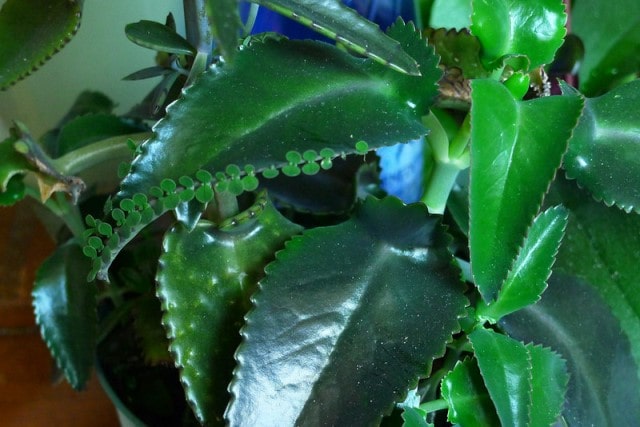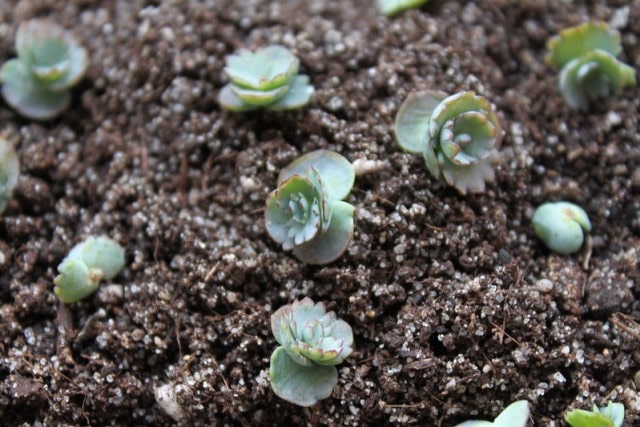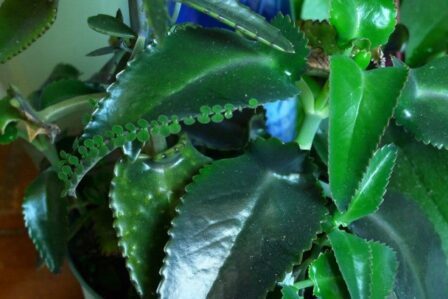Mother of Thousands was formerly known as Bryophyllumdaigremontianum, but its botanical name is Kalanchoe daigremontiana. Other common names for the mother plant include the Mexican hat plant, alligator plant, and devil’s spine. It is a plant of the genus Kalanchoe and is often confused with other plants. However, many are similar, such as Mother of a Million and Chandelier Plants. You probably can only tell them apart visually if you’re familiar with plants.
Consider adding a mother of thousands of plants to your indoor garden. These plants are very popular due to their low maintenance requirements. In this article, we’ll tell you everything you should know about this popular succulent and how to care for it.

What Makes the Mother of Thousands Plant Unique Succulents?
The properties for which Mother of Thousand plant makes it unique are as follows:
- Leaves
The leaves are beautiful, unique, large (up to 8 inches long), and serrated. They are fairly bright green, but some varieties have a slightly pinkish tinge, while others have a more muted shade of green. Although this is not common, Mother of Thousands can sometimes grow up to 3 feet tall. Most plants end up 18 to 24 inches. When they get much larger, the plants can appear leggy and hairy.
However, this is an easily solvable problem and a hardy little plant with little time and attention. The most striking feature of this plant’s leaves is the thousands of tiny seedlings that grow from the jagged edges of the parent plant’s leaves. These tiny saplings fall from their hosts with the slightest touch and can take root more or less wherever they land.
- Flowers
Mother of Thousands is not famous for flower production. However, the flowers it produces are unique. But with the right conditions, this succulent flower will be very beautiful. However, the flowering habits of this plant are unpredictable at best, and you may only see flowers after years of having the plant. How can you make them bloom? Well, the answer is multi-faceted. First, the plant needs proper light conditions. As with most flowering plants, more light means more flowers.
A long panicle extends from the center of the stock and branches off from the ends. Coral-pink bell-shaped flowers cascade down from the branches, resembling what you’d think of as a magical fairy dining room chandelier.
The downside of these wonderful flowers is that they only last once in a lifetime. Like many flowering succulents, when the inflorescence dies, so does the mother plant. You will find yourself dealing with more than you know what to do when this little plant chooses to take root.
MORE POSTS: How Often To Water Jade Plant In Winter?
How to grow a mother of thousands?
When growing these plants both indoors and outdoors, several important factors affect their growth. You must understand the soil profile, water needs, sun needs, etc. Let’s look at all aspects of their maintenance and care.
- Light requirements
They are light lovers, but the mother of thousands of plant care involves putting them in indirect bright light. It should not be placed on a windowsill that gets a lot of warm light, as it only works well in direct sunlight for a short time. Instead, let indirect light through windows closed with sheer curtains or outdoor shade fabrics. You can place it near a window to avoid direct strong light.
East-facing windows are best, but west or south-facing windows are also acceptable. Avoid placing it near a north-facing window, especially in summer. Also, avoid placing it in an area that needs to be removed frequently, as it can stress the plant. Instead, look for a location that receives indirect light year-round.
If you don’t have a suitable window, you can use LED lights that provide just the right amount of light without the sun’s glare. It is necessary for the plant, even on cloudy days and especially when the days are very dark.
- Temperature requirements
The ideal temperature for growing Mother of Thousands is between 65 and 75 degrees Fahrenheit or 16 and 24 degrees Celsius. Try to grow them in temperatures close to these ranges. Keep plants away from direct heat during the colder months of heating your home. Direct heat damages the leaves and dries out the plants quickly.
- Necessity of potting
If you are growing from seedlings, you don’t need to dig holes to plant the seedlings. Place the root side (attached to the mother plant) down in moist, succulent potting soil to encourage rooting. Don’t use pots that are significantly larger than the plant when potting adult plants.
Planting Mother of Thousands in pots of the same size will slow their growth. This succulent needs a lot of air circulation around its roots. The best type of pot for this is with a drainage hole in the bottom. Terracotta naturally soaks up water through its roots. To further improve drainage, place stones in the bottom of the pot to lift the roots and create circulation at the bottom of the root system.
Potted plants with other plants can be difficult. Seedlings can quickly fill space and choke companion plants in the same container. A separate pot is an ideal place for this plant.
- Water requirements
Water the mother of a thousand fully. Allow the plant to dry out so that the top 2 inches of soil is completely dry before watering again. Always use room temperature water when watering. Plant roots are very sensitive to temperature. Using too cold or too hot water can “shock” and damage the roots.
Another tip for watering a thousand mothers is to water only the soil and avoid getting water on the leaves. Plant leaves tend to rot when wet, but the plant should not dry out completely. Otherwise, the plant will become very dry and won’t be rejuvenated.
5. Soil requirements
Mother of Thousands grows best in well-drained sandy soil. Potting soil for cacti is a good choice. You can make your own if you don’t have sandy potting soil. Just add a little coarse sand to your regular potting soil. You can add a few other things to your soil for better drainage.
• Perlite – Perlite is crushed volcanic glass that can be added to potting soil to keep it light and fluffy.
• Pumice stone helps aerate the soil and keeps it loose for good drainage.
• Vermiculite – Made from mica, vermiculite retains moisture in the soil and increases aeration.
Avoid using soils containing peat moss, humus, or clay mixtures. Putting these in potting soil will take too long to dry, leaving too much water in the pot.
6. Fertilization
The growing season of these plants is from spring to summer or early autumn at the latest. We recommend fertilizing the plants during the growing season about every three months, but a little off is okay. Plants only need a few fertilizers.
Water the plant before fertilizing and use a balanced fertilizer specifically for succulents or a fertilizer with an NPK ratio of 15-15-15 or 10-10-10. It is an equal ratio of phosphorus, nitrogen, and potassium. Fertilizers, in most cases, need to be slightly diluted. Check package directions for a proper fertilizer-to-water ratio. If you notice the signs below after fertilizing your plants, stop for a few months before looking for a milder fertilizer.
• Dry leaves
• Striped (yellow, brown, or white)
• Leaves turn yellow or brown
If you notice any of these signs, remove the plant from its pot immediately and remove as much soil as possible. Put in new fresh soil, water and let the plants rest.
7. Pruning and maintenance
Mother of Thousands requires very low maintenance. It needs moderate water and less fertilization. Trimming brown and damaged foliage is a necessity. However, you can skip pruning. Trimming away damaged foliage can be done at any time. Use a sharp and clean tool for cutting or chopping the damaged leaves. If your plant seems leggy, just snip off the tops above the larger leaves in spring. It encourages branching and helps the plant fill that space.
8. Repotting
Mother of Thousands doesn’t need to be repotted often like many succulents. This plant is slowly growing and usually needs a larger pot every few years. When you notice the roots starting to grow through the drainage holes at the pot bottom, you know it’s the time! If the soil is drying out faster than it used to or if the leaves and stem seem stunted in growth – these are also signs it’s time to repot.
Wait until spring to repot the plant. Then find a pot that’s the “next size up” from the current size for the repot, or, perhaps, two sizes up, depending on your preferences. The plant will do fine in either. Ensure this new pot includes proper drainage.
How to Propagate a Mother of Thousands of Plants?

Propagating a mother of thousands of succulents is relatively easy. Follow the below steps to grow a new plant from the mother plant:
- Remove the baby plantlets. As the mother plant goes dormant, the small plantlets will drop naturally from the large leaves in late winter. Remove the baby plants from the main mother branch.
- Add the plantlets to the soil. Treat the mother of thousands of plantlets like you would plant other baby succulents. Place the freshly-cut baby stem in nutrient-rich soil such as cactus mix. Then water it well. The baby plant needs more nutrients and light initially than the mother plant.
- Replant the new plant—young transplant plants similar to a mature mother of thousands of plants. Once the seedlings have developed a root system, place them in small terracotta pots filled with a cactus mix or well-draining potting soil.
Pests and Diseases
Consider some aspects if you’re giving Thousand Mothers a chance. Pests can come to new plants and migrate to established plants. So be careful when checking new plants.
- Aphids
Aphids are small, soft-bodied insects sucking sap from plants and leaving an unpleasant white residue. The juicy leaves of this plant attract aphids. Aphids are visible, but you may only notice them once they start damaging plants. If the leaf curls or fades and looks like something is sucking its life out, turn it over and look for aphids.
If your plants have aphids, spray them with soapy water or a neem oil solution. It kills aphids by blocking their ability to breathe and suffocating them. If more eggs hatch and you need treatment again after a week or two, don’t panic. Manually wipe off any remaining sticky residue with a clean, soft cloth.
- Mealybugs
Mealybugs are small white insects feeding on the leaves of succulents by hiding under the leaves. Mealybugs can be killed by wiping them with a cotton swab soaked in alcohol, but insecticide may be required for severe infestations. Find delicious and filling meals with Kalanchoe plants. Young scales move, but they stay in roughly the same place and feed as they grow. If your leaves turn yellow and you see small brown spots under the leaves, it may be dandruff.
Dandruff can be wiped off with a damp cloth. Neem oil also effectively removes these types of dandruff if they are severely infested. Take a cotton swab, put it in alcohol, and clean the leaves.
- Powdery Mildew
This fungal disease is another common disease affecting this particular succulent and is usually caused by too much moisture in the air. It is not a very serious problem and can usually be treated successfully.
Other care instructions and warnings
• All parts of thousands of mother plants contain toxic compounds. So, if you have small children or pets who like to nibble on your plants, consider placing the pot on a high shelf to make it inaccessible.
• If the plant grows too tall for its location, the stem can be cut back to half its height. Tucking the cut stem section into a pot of potting soil will make it root and give you more plants to share with your friends.
• Unlike tropical indoor plants, Thousand Plant matrices do not require high humidity.
• Keep plants away from forced air heating ducts and other hot or cold winds that can affect the plant’s overall health and cause young seedlings to fall prematurely.
Final words
Whether you call it the Mother of Thousands, Mexican Hat Plant, Alligator Plant, or Devil’s Spine, this special plant deserves a spot on your favorite botanical shelf. These tips will help you grow healthy succulents in your house garden.

